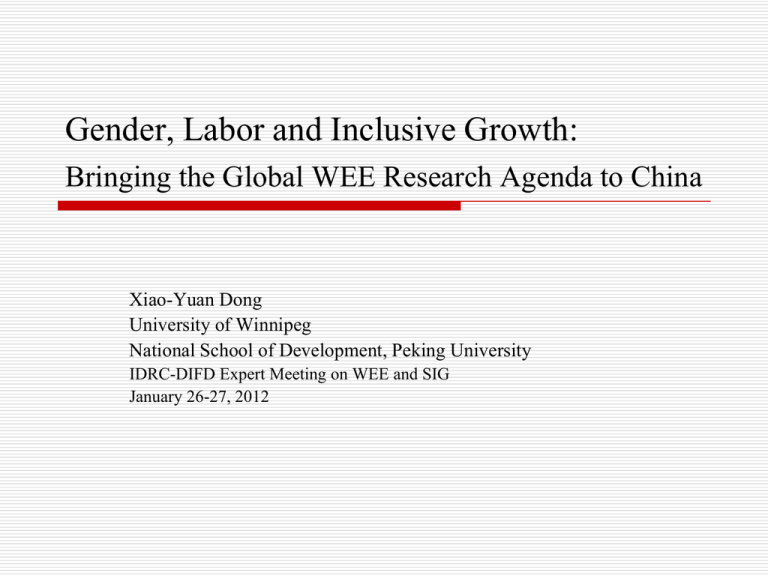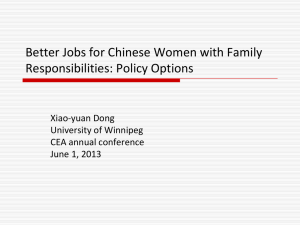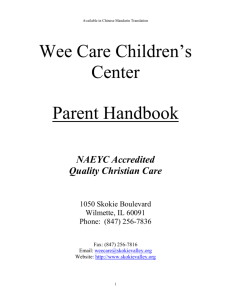Gender, Labor and Inclusive Growth in China
advertisement

Gender, Labor and Inclusive Growth: Bringing the Global WEE Research Agenda to China Xiao-Yuan Dong University of Winnipeg National School of Development, Peking University IDRC-DIFD Expert Meeting on WEE and SIG January 26-27, 2012 Contents - Background Research agenda Troops on the ground Introduction to Chinese Women Economists (CWE) Research Training Program Background Chinese economy over the past three decades has undergone dramatic transformations and rapid economic growth. The rapid economic growth has lifted more than 400 millions of people out of poverty and substantially improved the living standards of Chinese people. However, the benefits of economic growth have not been distributed evenly; the rising income inequality in post-reform China has been a subject of considerable attention. Studies based on national representative data also show that while the economic growth has raised the economic well-being of both Chinese men and women in absolute terms, the status of women relative to men in the labor market have deteriorated, especially after the SOE-sector restructuring in the late 1990s. China's GDP per capita (1978=100), 1978 - 2009 1400 1200 1000 800 600 400 200 Source: NBS China Statistical yearbook, 2009 Table 2-5 20 08 20 06 20 04 20 02 20 00 19 98 19 96 19 94 19 92 19 90 19 88 19 86 19 84 19 82 19 80 19 78 0 Rising Human Development Index HDI China's Human Development Index, 1975 - 2008 0.85 0.8 0.75 0.7 0.65 0.6 0.55 0.5 0.45 0.4 0.756 0.763 0.772 2005 2006 2007 0.793 0.719 0.657 0.608 0.53 0.533 1975 1980 0.556 1985 1990 1995 2000 Year 2008 Trends of income and consumption inequality between 1988 and 2003 Gini coefficients Ratio of top 10% to bottom 10% in consumption 1988 1995 2003 1991 2003 National 0.39 0.44 0.45 2.43 5.66 Rural areas 0.32 0.38 0.37 Urban areas 0.23 0.28 0.32 Per capita income ratio Urban/rural 2.0 2.8 3.1 Richest/poore st province 3.5 5.9 8.0 Source: Qian (2005) Rising gender inequalities in the labor market Rising gender gaps in labor force participation Urbam males' labor force participation rates, 1993, 2000, 2006 100 100 90 90 80 80 70 70 60 1993 50 2000 40 2006 % % Urban female labor force participation rates, 1993, 2000, 2006 60 1993 50 2000 40 2006 30 30 20 20 10 10 0 0 16-25 26-35 36-45 46-55 Age Source: CHNS 56-65 65 + 16-25 26-35 36-45 46-55 Age 56-65 65 + Prime-aged women withdrew from the labor market at higher rates than their male counterparts. Changes in labor force participation rates by gender and by age, 1993 - 2006 0 -5 -10 % -15 -20 -25 -30 16-25 26-35 46-55 36-45 Age 56-65 65 + Female Male Prime-aged women were also more likely than men to be laid off and had greater difficulty finding reemployment (Du and Dong, 2009). Urban unemployment rate by gender and by age, 2003 30 25 % 20 Female 15 Male 10 5 0 20-24 25-29 30-34 35-39 40-44 Age Source: China’s urban labor survey 45-49 50-54 55-59 60-64 The decline in women’s employment was concentrated among those married to low-earning husbands (Ding, Dong and Li 2010). Employment rates of wives by quintile of husbands' income distribution 100 95 90 % 85 1988 80 1995 2002 75 70 65 60 1st 2nd 3rd 4th Quintile of Husbands' income distribution Source: Chinese household income survey 5th Women were more likely than men to experience downward occupational mobility, moving into jobs with lower pay and less skill requirement (Song and Dong, 2009). Frequency distribution of occupational mobility by direction 45 40 42.9 37.6 37.2 35 28.5 30 28.6 % Male 25.2 Female 25 20 15 10 Downward Horizontal Source: Chinese Women Social Status Survey (2000) Upward A growing number of urban workers, predominately women, have been pushed into the informal sector (Yuan and Cook 2010) Share of informal employment, 1997-2006 45 39.9 40 33.9 35 30 24.2 25 1997 % 20.5 2006 20 15 10 5 0 Male Source: CHNS Female Growing gender wage disparities: The ratio of female to male earnings fell from 0.84 in 1987 to 0.76 in 2004 (Chi and Li, 2008) Annual earnings by gender (yuan) 4500 4215 4000 3500 3203 3000 2500 Male 2190 Female 1822 2000 1542 1500 1293 1000 500 0 1987 1996 2004 Source: China’s urban household survey (Chi and Li, 2008) The gender earnings gap went up from 1987 to 2004, more dramatically for lower deciles. Raw gender earnings gaps by decile, 1987-2004 0.4 0.35 0.3 0.25 1987 0.2 1996 2004 0.15 0.1 0.05 0 10th 20th 30th 40th 50th 60th 70th 80th 90th Decile Source: China’s urban household survey (Chi and Li, 2008) Economic disparities between urban and migrant workers Urban workers Migrant workers Male Female Male Female Formal sector 82% 81% 45% 37% Self-employed 9% 7% 30% 27% Temporary workers 9% 12% 25% 34% Wages (Yuan/month) 2,475 1,987 1,934 1,309 Working hours/week 42.2 36.3 65.0 61.6 Source: 2008 urban and migrant household survey. Feminization of the rural economy The share of work done by women aged 15 and older 90 80.9 80.8 80.6 80 70 % 60 55.1 55.4 58 55.4 55.5 57.6 1991 41.9 44.2 50 2000 40 2006 30 23.6 20 10 0 Farm work Sources: CHNS Off-farm work Domestic work Total work time Compared to men, working women have longer work hours and higher time poverty rates (Dong and An, 2011). Men Women Paid work (Hour/week) 41.3 37.7 Unpaid work (hour/week) 11.4 23.2 Total (hour/week) 52.7 60.9 Time poverty rate (>80 hours/week) 5.6% 10.2% Source: China time use survey 2008 • Despite the aforementioned setbacks, due to the socialist legacy and rapid economic growth, gender inequalities in China remain lower relative to many countries at similar levels of development. Human development index ranking China Gender inequality index ranking GII-HDI 89 38 -51 The United States 4 37 33 Canada 8 16 8 Russia 65 41 -24 Brazil 73 80 7 South Africa 110 82 -28 India 119 122 3 Source: UNDP Human Development Report 2010, Table 4 New challenges to WEE and SIG in China With the ending of “population dividends” and raising labor costs, the Chinese economy faces the massive destruction and reallocation of jobs in low-end manufacturing. - If not handled properly, this process will further polarize China’s employment structure, exacerbate income inequality, and worsen women’s position in the labor market. Chinese government’s response - Boost internal consumption Develop broad-based social protection and security schemes Raise official poverty line to 2,300 yuan (≈$1.25/day) □ Bringing the WEE and SIG to China is of timely importance. 2. Research agenda 1. Need to improve methodologies Limitations of the existing research on gender and economic transformations in China - Tend to stress the instrumental rationale of gender equality more than - the intrinsic rationale; Narrowly focus on the market sector and paid work; Lack of a macroeconomic perspective; Quantitative analysis and inadequate attention to policy relevance. Methodological Improvements - Place greater emphasis on the intrinsic rationale of WEE in - - the gender and development discourse; Look at women’s work in its totality, paying attention to the tradeoffs of paid work and unpaid family responsibility facing women, especially those from low-income families; Link the research on WEE to macroeconomic policies; Encourage pluralistic research methods and policy-oriented research. 2. Issues need to be explored Facilitating growth with decent jobs Macro-issues • • Examine the impacts of the industrial upgrading process on the gender patterns of employment Develop gender-sensitive labor policy and social protection schemes - Issues concerning WEE in the formal sector • What obstacles are there to women’s entry to and career advancement in the sector? What obstacles are there to women’s rising to managerial leadership positions? What policy measures may help foster family-friendly, gender equalityenhancing practices at the firm level? How do such practices affect both enterprise productivity and the well-being of male and female workers? • • • 2. Issues need to be explored • Issues concerning WEE in the informal sector - Special attention to two groups: - Migrant workers and paid domestic workers Their earnings, working conditions, access to social protections and financial services, organized voice and capacity to bargain for fairer returns to labor • - Issues concerning WEE in the rural sector - Impacts of the feminization of agriculture on labor productivity and the wellbeing of female farmers and their families Special attention to left-behind non-elderly women and the elderly 2. Issues need to be explored Enhancing enterprise development, entrepreneurship and innovation - What are the main reasons for women to start business? What factors are attributable to the performance differences between women and men entrepreneurs? What role do women play in enterprise innovation? Earnings, productivity, working conditions, access to finance and social protections, voice and organizations of self-employed women and men 3. Troops on the ground The Chinese Women Economists (CWE) Research and Training Program of the National School of Development, Peking University (www.CEW.org.cn) - Established in 2002 under the sponsorship of the Ford Foundation - Have provide research trainings for more than 200 young CWEs from more than 100 Chinese universities and research institutes - 32 established scholars from Australia, Canada, the UK, the US, returning westtrained Chinese scholars have participated in research mentoring - Have published about 70 articles (with research mentors) in international refereed journals - Hosted the 2011 IAFFE Annual conference in Hangzhou 3. Troops on the ground The goals of the program in its second decade - Mainstream gender in economic education, research and policy making in China Work together with Chinese male economists and returning west-trained junior economists Needs for further capacity building - Gender research, case study, policy analysis, writing skills











